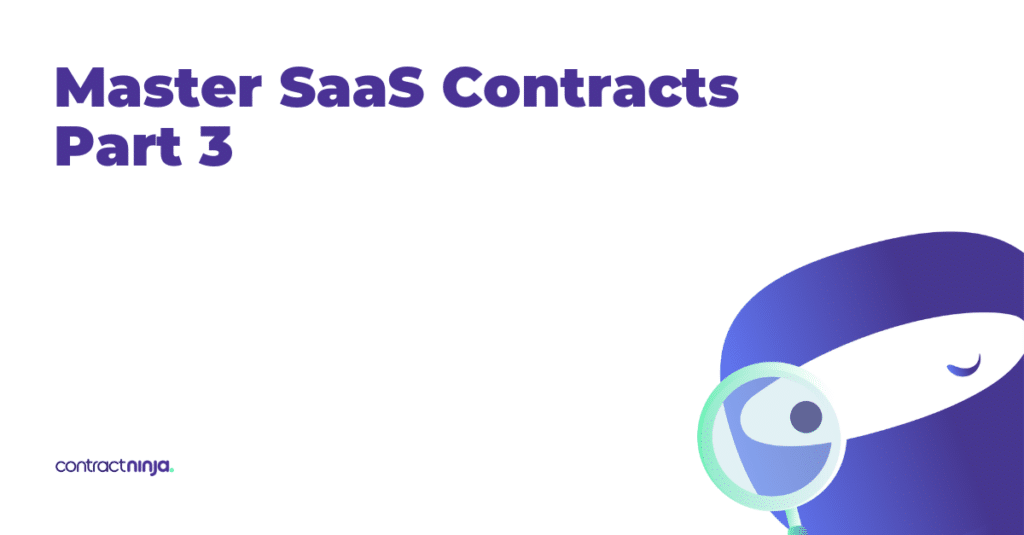Home » Publications » Master SaaS Contracts Part 3

This article is published with permission from the editor of De Rebus. This article was first published in De Rebus in 2023 (Dec) DR 33. The original article was also published on the De Rebus website at www.derebus.org.za on 1 December 2023.
The 1st article discussed the difference between Software Licensing and the Software as a Service model.
The 2nd article discussed access and suspension rights, restrictions relating to the use of the SaaS and the provider’s right to make changes to the SaaS.
This article will look at provisions often heavily negotiated by legal teams, which include limitation of liability, warranties and indemnification.
According to the latest data provided by World Commerce and Contracting, limitation of liability provisions ranks as the most negotiated term in contracts.
Limitation of liability provisions are, in essence, risk apportionment provisions – if the SaaS Provider’s liability for certain events is excluded or limited in any way, the risks relating to that event become that of the Customer.
For example, let’s say the SaaS forms a core component of the Customer’s operations, and something goes horribly wrong with the SaaS, which causes the Customer to lose millions. The Customer would obviously want to hold the SaaS Provider responsible. On the other hand, such a claim will likely put the SaaS Provider out of business.
Limitations of liability provision are, therefore, a fine balancing act.
In practice, Parties will generally agree that neither party may claim indirect or consequential damages from the other party. The SaaS Provider would then also push for a limitation on claims relating to direct damages (often referred to as a “cap”, which is placed on claims relating to direct damages suffered by the Customer).
Generally, Customers will be open to agreeing to a cap to be placed on claims for direct damages. The cap amount and the calculation often come down to an arm wrestle (i.e., the Parties’ bargaining power and the Parties’ risk profiles).
Importantly, Customers would want to exclude certain claims from the cap placed on direct damages (in practice, these exclusions are often called “carve-outs”).
The usual suspects (i.e. claims which will not be subject to the cap) include claims relating to gross negligence, willful misconduct, and fraud. An alert Customer may also push to exclude claims relating to breach of confidentiality, breach of data protection provisions or breach of applicable laws.
Then, there are also situations where a Customer may require that the SaaS Provider indemnify them against any third party intellectual property infringement claims. If this is the case, claims under the indemnity are also generally excluded from the liability cap.
On the other hand, the Customer may feel that the carve-outs, especially those related to claims for breach of confidentiality and data protection provisions, may expose them to significant risks they cannot take.
In the above situation, the Customer may require that the claims relating to breach of the confidentiality and data protection provisions not be carved out but that these claims be made subject to a “super cap”. In other words, there is still a cap on these types of claims, but the cap placed on these claims is much higher.
Generally, a SaaS product is not specifically designed for a single Customer. For this reason, the SaaS provider would not want to make any warranties relating to the SaaS’s suitability for a specific use case or that the SaaS will work with the Customer’s current systems.
Additionally, a SaaS Provider does not want to make any warranties that the SaaS will be “error-free”. There are just too many moving parts. Instead, SaaS Providers generally provide an SLA which addresses the correction of any errors which may arise during the use of the SaaS product.
From the Customer’s perspective, you want to at least include warranties that provide that the SaaS will function in all material respects as stipulated in the SaaS Documentation.
An aspect often overlooked related to warranty provisions in SaaS contracts is the remedies available to the Customer if there is a breach of warranty. What if the SaaS Provider cannot bring the functionality of the SaaS in line with the Documentation? Will the Customer be entitled to cancel and receive a full refund? These are important questions from a Customer’s perspective, and the contract must clearly provide what happens if there is a breach of warranty.
From the SaaS Provider’s perspective, you want to add exclusions where the Customer cannot claim a breach of warranty. For example, think about the situation where the SaaS is used in a manner not provided for in the Documentation; then, the Customer must not be able to claim a breach of warranty.
The most common indemnity included in SaaS Agreements is an indemnity against third-party IP claims. As a Customer, you don’t want a situation where someone institutes an intellectual property infringement claim against you because of your use of a SaaS product.
Most of the time, the SaaS Provider will be willing to indemnify the Customer against IP claims. However, there will generally be a couple of carve-outs.
As a SaaS Provider, you don’t want to indemnify the Customer if the Customer uses the SaaS product in such a way that it violates the terms of the SaaS Agreement or if the Customer combines the SaaS product with any other product, resulting in an IP infringement claim.
The amount which can be claimed under the indemnity is also often a topic of negotiation. From the Customer’s perspective, you want to be indemnified for all possible expenses and losses you can possibly think of.
From the SaaS Provider’s perspective, you want to define the indemnified losses payable under the indemnity as narrowly as possible and limit these losses to foreseeable reasonable losses.
Additionally, the SaaS Provider would want to have the right to control any legal proceedings related to the IP infringement claim brought against the Customer.
Crafting a SaaS Agreement involves achieving a fair balance of interests, where risk is appropriately shared, and both parties have clear, actionable paths in case of breaches. This balance fosters a positive, long-term relationship between the SaaS Provider and the Customer, ultimately leading to mutual success in their business endeavours.

Master Contracts, elevate your career. Join the global movement of shaping the standard of contracts.
South Africa
194 Bancor Avenue Menlyn, Colab Building, Waterkloof Glen, Pretoria, 0181
United States


Form part of the spearhead movement of shaping the global standard for tech contracts.